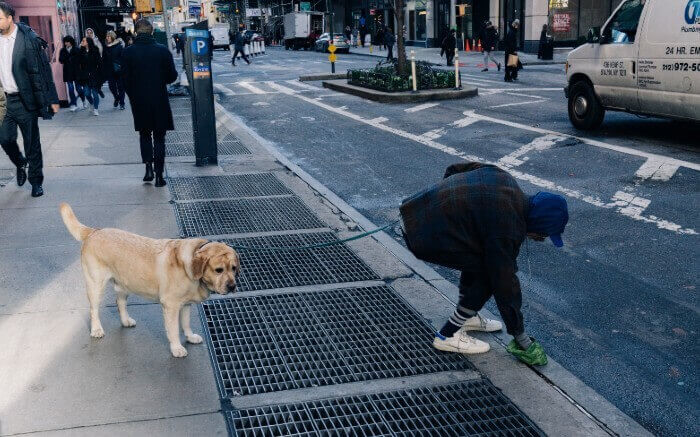Why You Need to Check Your Dog’s Poop

DogFoodAdvisor is reader supported See how
Dog Food Advisor is 100% impartial and is never paid to promote any brand. But if you buy using links on this page, we may earn a referral fee.
Dog poop. It’s not glamorous, but it’s part of every dog parent’s daily life. And every responsible dog parent needs to be clued up on what comes out of the rear end of their pet.
This is because dog poop gives you a pretty good idea of what’s happening with your dog’s insides — and can often be the first sign something’s not quite right.
A dog’s stool also lets parents know if their pet’s nutritional requirements are being met or if a dietary change is required.
So without further ado, here’s a crash course on how dog poop should look and how to inspect a dog’s stool.
What should my dog’s poop look like?
Next time your dog goes about its business, take a glance at the form and consistency of the poop. Hard and small is often a sign of constipation, dehydration or fiber deficiency; soft stools or diarrhea can be a symptom of an infection or parasite, or nutritional issues such as poor quality or hard-to-digest ingredients.
The smell is also an indicator of quality: it’s never going to smell of roses, but your dog’s poop shouldn’t have a stomach-churning stench. If it does, it could be a sign of diet- or gut-related problems.
Somewhere between these extremes is ideal: firm and easy to scoop, with less odor.
The vets working at The Farmer’s Dog have provided this useful visual guide so you know what to look out for.

Why is my dog’s poop a weird color?
Sometimes, it’s not so much the shape that’s a cause for concern, but the hue. Depending on a dog’s gastrointestinal health, a stool can come out in a wide range of colors, from dark black and red to grey or green. Again, the experts at The Farmer’s Dog have lent us another informative illustration — this one explaining the potential reasons behind different shades.

What about white dog poop?
Parents who were about in the 1970s might remember seeing white dog poop on the ground, but this is rarely spotted today.
That’s because bone meal used to be one of the main ingredients in commercially produced dog food and this contains way more calcium than a dog can handle — instead of being digested, excess calcium comes out in their poop instead, lending it an unhealthy white color.
Today, we’re happy to say most dog food contains better calcium quantities.
What else do I need to look for in my dog’s poop?
The information above gives you a good guide to your dog’s stool and how it should look. But there are couple more things you should bear in mind when it comes to dog poop.
What should I do if there’s a foreign object in my dog’s poop?
You might think it’s bad news if you spot something your dog shouldn’t have eaten in their stool, be that a plastic toy or a chicken bone. However, the alternative is that this unfamiliar item gets stuck in their digestive system, which can cause issues in the long run.
If you spot a foreign object in your dog’s poop, it’s worth checking it’s intact and detachable parts aren’t still inside your pet. Otherwise, they could be at risk of bowel obstruction.
If you suspect this might have happened or the reappearance of the object is accompanied by vomiting, call the vet pronto.
How often should my dog poop?
As long as the poop coming out is healthy, a parent doesn’t need to be overly worried about the frequency with which a dog needs to go — some pets will be fine going once a day, but others will be scratching at the back door more often.
This tends to change over the course of their lifetime, too. Puppies can poop up to four or five times a day as a result of their regular calorific meals, while senior dogs with a smaller appetite and sedentary lifestyle can hold on for longer.
The only time a parent should be concerned is if they witness a dramatic shift in frequency. An unexpected barren patch could be constipation — and it’s recommended to get the vet involved if this lasts longer than two days.
If your dog’s pooping way more than you’d expect, make sure to check this isn’t diarrhea and keep an eye out for other abnormal symptoms — lethargy, fever or vomiting at the same time isn’t good. Again, it’s best practice to get your vet’s opinion if it goes on for longer than a couple of days.
And remember, the next time you scoop, have a snoop.
Final word
The Dog Food Advisor does not accept money, gifts, samples or other incentives in exchange for special consideration in preparing our reviews.
However, we do receive a referral fee from online retailers (like Chewy or Amazon) and from sellers of perishable pet food when readers click over to their websites from ours. This helps cover the cost of operation of our free blog. Thanks for your support.
For more information, please visit our Disclaimer and Disclosure page.



